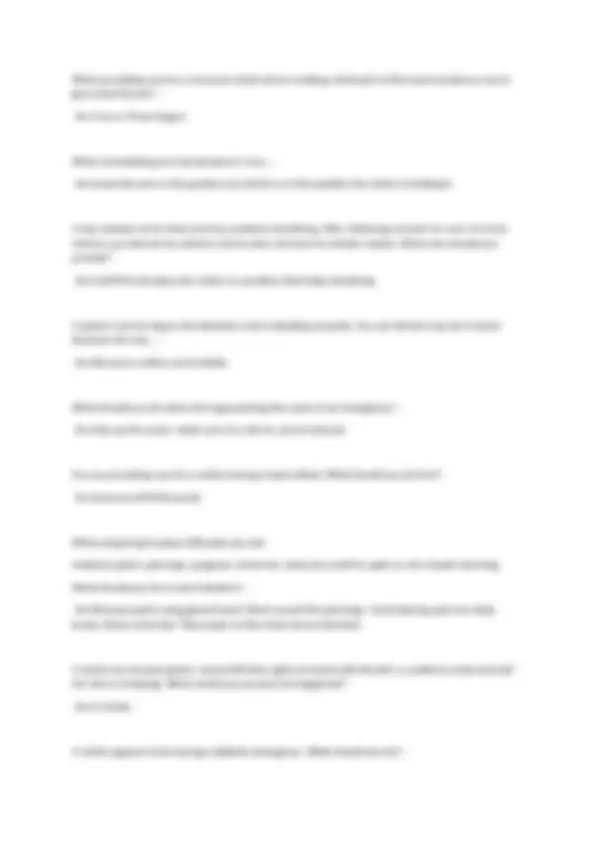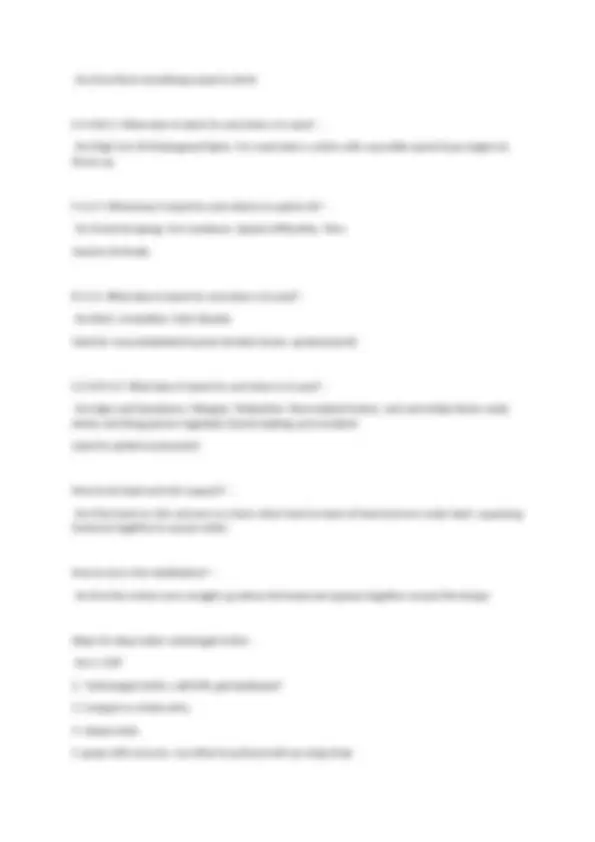





Study with the several resources on Docsity

Earn points by helping other students or get them with a premium plan


Prepare for your exams
Study with the several resources on Docsity

Earn points to download
Earn points by helping other students or get them with a premium plan
Community
Ask the community for help and clear up your study doubts
Discover the best universities in your country according to Docsity users
Free resources
Download our free guides on studying techniques, anxiety management strategies, and thesis advice from Docsity tutors
Red Cross Lifeguarding Test with correct Answers.
Typology: Exams
1 / 7

This page cannot be seen from the preview
Don't miss anything!




CPR Should be performed on a victim who is... - Ans In Cardiac Arrest. An unconscious victim with an obstructed airway has similar steps but the process is not called CPR C.A.B. What does it stand for and when is it used? - Ans Circulation, Airway, Breathing. Chest compressions (30). Airway (open). Breaths (2) Used for CPR Rate of chest compressions during CPR? - Ans 100 BPM (Roughly the tempo of the song "Staying Alive" by the BeeGees. Ironically, it is also the tempo of "Another One Bites The Dust" by Queen. You are performing CPR when a second lifeguard arrives. What is most appropriate for the second lifeguard to do first? - Ans Check to see whether EMS personell have been called. After an AED says "No Shock Advised," it is best to... - Ans Perform CPR for about 2 minutes. Adult chest compressions, how do you position your hands? - Ans Heel of one hand on the center of the chest with the other hand on top. As the only lifeguard performing CPR on an 7-year old, you would perform cycles of... - Ans 30 chest compressions and 2 ventilations. The cycle of chest compressions and ventilations in two-rescuer CPR for an infant is... - Ans 15 chest compressions and 2 ventilations. Hand placement for CPR for an:
Adult, Child, Infant - Ans Adult and child: Heel of one hand in center of chest (on lower half of sternum) with the other hand on top Infant: 2-3 fingers on center of chest (just below nipple line) Process of using AED - Ans Turn on machine. Apply the pads. Plug into machine. Follow instructions. CPR should continue during the setup. Child is choking (conscious). After activating EAP and getting consent from the parents, what should you do next? What about someone unconscious? - Ans Stand or kneel behind the victim and give 5 back blows and 5 abdominal thrusts. For unconscious do CPR. Depth of chest compression for CPR for an: Adult, Child, Infant - Ans Adult and child: 2 inches Infant: 1.5 inches To ensure effective chest compressions during CPR, what should be noted? - Ans The chest is able to fully recoil between compressions. You are performing CPR on a victim when you notice the chest begins to rise and fall. What do you do first? - Ans Stop CPR and reassess the victim's breathing and pulse. If the breathing is not regular, continue CPR as though no breathing were present. When giving a primary ventilation to an adult who is unconscious and not breathing, you notice the chest is not rising. What should you do next? - Ans Re-tilt the head and attempt another ventilation. You are giving ventilations through a resuscitation mask, and the victim vomits. What should you do?
When providing care to a conscious infant who is choking, what part of the hand would you use to give chest thrusts? - Ans Two or Three fingers. When immobilizing an injured patron's arm... - Ans Leave the arm in the position you find it or in the position the victim is holding it. A boy clutches at his chest and has problems breathing. After obtaining consent for care, his mom informs you that he has asthma, but he does not have his inhaler nearby. What care should you provide? - Ans Call EMS and place the victim in a position that helps breathing. A patron cuts her leg on the bleachers and is bleeding severely. You can tell she may be in shock because she may... - Ans Becomes restless and irritable What should you do when first approaching the scene of an emergency? - Ans Size up the scene, make sure it is safe for you to interact. You are providing care for a victim having a heart attack. What should you do first? - Ans Summon EMS Personell. When preparing to place AED pads you see: medicine patch, piercings, pregnant, chest hair, body too small for pads so risk of pads touching. What should you do in each situation? - Ans Remove patch using gloved hand. Work around the piercings. Avoid placing pad over baby bump. Shave chest hair. Place pads on the chest and on the back. A victim has slurred speech, cannot lift their right arm level with the left, is unable to smile and half her face is drooping. What would you assume has happened? - Ans A stroke. A victim appears to be having a diabetic emergency. What should you do? -
Ans Give them something sweet to drink H.A.IN.E.S. What does it stand for and when is it used? - Ans High Arm IN Endangered Spine. It is used when a victim with a possible spinal injury begins to throw up. F.A.S.T. What does it stand for and what is it used to ID? - Ans Facial drooping, Arm weakness, Speech difficulties, Time. Used to ID Stroke R.I.C.E. What does it stand for and when is it used? - Ans Rest. Immobilize. Cold. Elevate. Used for musculoskeletal injuries (broken bones, sprained joint) S.A.M.P.L.E. What does it stand for and when is it used? - Ans Signs and Symptoms. Allergies. Medication. Past medical history. Last oral intake (food, meds, drinks, last thing person ingested), Events leading up to incident. Used for patient assessment. How to do head and chin support? - Ans One hand on chin and arm on chest, other hand on back of head and arm under back. squeezing forearms together to secure victim. How to do in-line stabilization? - Ans Put the victims arms straight up above the head and squeeze together around the biceps Steps for deep water submerged victim. - Ans 1. EAP